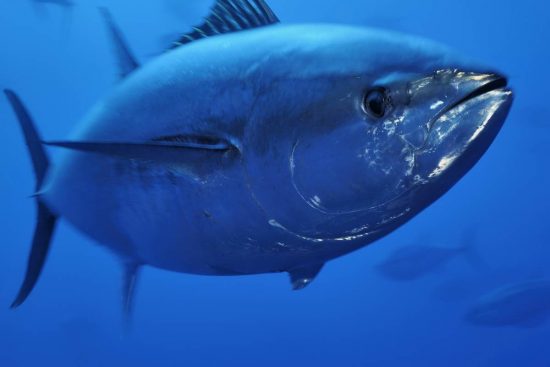




Researchers tag fish with satellite trackers
After an absence of more than 50 years, the endangered bluefin tuna has returned to the North Sea. A joint research project by WWF and universities in Sweden and Denmark has tagged these predators with satellite trackers to better understand them and track their movements.
Over two weeks in September, with the help of experienced sports fishermen, the researchers have caught 40 bluefin tuna, tagged them with satellite trackers and then released them between Skagerak and Kattegat.
In addition, they also took DNA samples from the fish to identify which of the two bluefin tuna stocks in the Atlantic they belong to. This is important because the Gulf of Mexico stock and the Northeast Atlantic-Mediterranean stock are categorised under different management systems.
Decades of heavy overfishing had driven the bluefin tuna in the Northeast Atlantic and Mediterranean Sea to the brink of extinction. It was only after an intensive advocacy for sustainable fisheries management that the population in the Mediterranean has shown signs of recovery.
"The return of bluefin tuna is a great success. As one of the world's most valuable fishes, its stock has been over-exploited and illegally plundered for decades. If the iconic predators are returning to the North Sea, we need to make sure they survive in the future, so we need more information about why this happens now,” said Catherine Zucco, a fishery expert at WWF Germany, in German.
Scientists traced the cause of the animals' disappearance from Swedish and Danish waters in the 1960s to overfishing of them and their prey, as well as to changes in the ocean conditions. “We don’t know why they now have begun to return but probably improved management and conservation measures are helping,” said Professor Brian MacKenzie from the Technical University of Denmark (DTU Aqua).
Dr Andreas Sundelöf from the Swedish University of Agricultural Sciences (SLU Aqua) added, “If we understand the reasons why the tuna has returned, we might be able to identify the factors that will enable them to keep coming here in the future. Bluefin tuna is a large predator at the top of the food chain which makes them essential for a healthy ecosystem.”
The tags record information on the location of the animals, swimming depth, light conditions and water temperature. After a year, the tags will detach from the animal, float to the water surface and transmit their data to the scientists via satellite. This will provide insights into the fish’s migration routes and their spawning and feeding grounds.
As Sweden and Denmark do not have catch quotas for bluefin tuna, a special permit for catching the fish has been issued for the project by the International Commission for the Conservation of Atlantic Tunas (ICCAT).
More information: www.wwf.de
 Herbert
Herbert 2nd October 2017
2nd October 2017